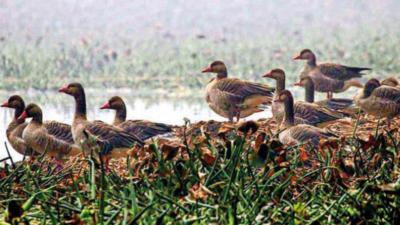Top Searches
- News
- City News
- noida News
- More birds, but fewer species: Survey blames delayed cleaning in Gautam Budh Nagar's Surajpur wetland
More birds, but fewer species: Survey blames delayed cleaning in Gautam Budh Nagar's Surajpur wetland

A total of 3,137 waterbirds were recorded at the Surajpur wetland this year
NOIDA: The Asian Waterbird Census (AWC) 2023 at the Surajpur wetland found 3,137 waterbirds of 37 species this year against 1,453 waterbirds of 46 species last year.
The continuation of the work of hyacinth removal till November last year resulted in some winter migratory species, including duck species, not landing at the wetland, said the AWC officials. The AWC is being conducted at nine wetlands in NCR from January 722, 2023. Similar exercises will be held in Okhla Bird Sanctuary and Dhanauri wetland soon.
AWC Delhi state coordinator T K Roy said, “We conducted the census at Surajpur Wetland in Greater Noida with a group of experienced birder volunteers. We recorded 3,137 waterbirds of 37 species, including 17 resident species and 20 winter migratory birds.” Last year, the wetland recorded 1,453 waterbirds of 21 resident species and 25 migratory species.
Roy said cleaning activity in the wetland in the peak winter season led to disturbance, with some migratory birds, including several duck species, flying away due to the ongoing work. The Surajpur wetland is annually cleared of hyacinth to make space for the winter migratory waterbirds. This work, usually completed before the birds start to arrive in September-October, continued till November last year. So, birders recorded a delayed arrival of the migratory birds in late November and December.
The census found dominating numbers of migratory greylag geese (740)which usually arrive from Central Asiaand migratory ducksnorthern shoveler (672) and common teal (373)which come from north Asia. The wetland also recorded a good number of bar-headed geese and nine species of ducks.
The other areas where the census will take place are Okhla Bird Sanctuary, Dhanauri Wetland, Najafgarh Jheel, Sultanpur National Park, Bhindawas Wildlife Sanctuary, Yamuna River, Sanjay Lake, and National Zoological Park.
The initiative is a part of the International Waterbird Census (IWC), which supports the conservation and management of wetlands and waterbirds worldwide. The environment ministry uses the census data as one of its tools for the national action plan for conservation of migratory birds and their habitats along the Central Asian flyway.
The continuation of the work of hyacinth removal till November last year resulted in some winter migratory species, including duck species, not landing at the wetland, said the AWC officials. The AWC is being conducted at nine wetlands in NCR from January 722, 2023. Similar exercises will be held in Okhla Bird Sanctuary and Dhanauri wetland soon.
AWC Delhi state coordinator T K Roy said, “We conducted the census at Surajpur Wetland in Greater Noida with a group of experienced birder volunteers. We recorded 3,137 waterbirds of 37 species, including 17 resident species and 20 winter migratory birds.” Last year, the wetland recorded 1,453 waterbirds of 21 resident species and 25 migratory species.
Roy said cleaning activity in the wetland in the peak winter season led to disturbance, with some migratory birds, including several duck species, flying away due to the ongoing work. The Surajpur wetland is annually cleared of hyacinth to make space for the winter migratory waterbirds. This work, usually completed before the birds start to arrive in September-October, continued till November last year. So, birders recorded a delayed arrival of the migratory birds in late November and December.
The census found dominating numbers of migratory greylag geese (740)which usually arrive from Central Asiaand migratory ducksnorthern shoveler (672) and common teal (373)which come from north Asia. The wetland also recorded a good number of bar-headed geese and nine species of ducks.
The other areas where the census will take place are Okhla Bird Sanctuary, Dhanauri Wetland, Najafgarh Jheel, Sultanpur National Park, Bhindawas Wildlife Sanctuary, Yamuna River, Sanjay Lake, and National Zoological Park.
The initiative is a part of the International Waterbird Census (IWC), which supports the conservation and management of wetlands and waterbirds worldwide. The environment ministry uses the census data as one of its tools for the national action plan for conservation of migratory birds and their habitats along the Central Asian flyway.
Start a Conversation
FOLLOW US ON SOCIAL MEDIA
FacebookTwitterInstagramKOO APPYOUTUBE









